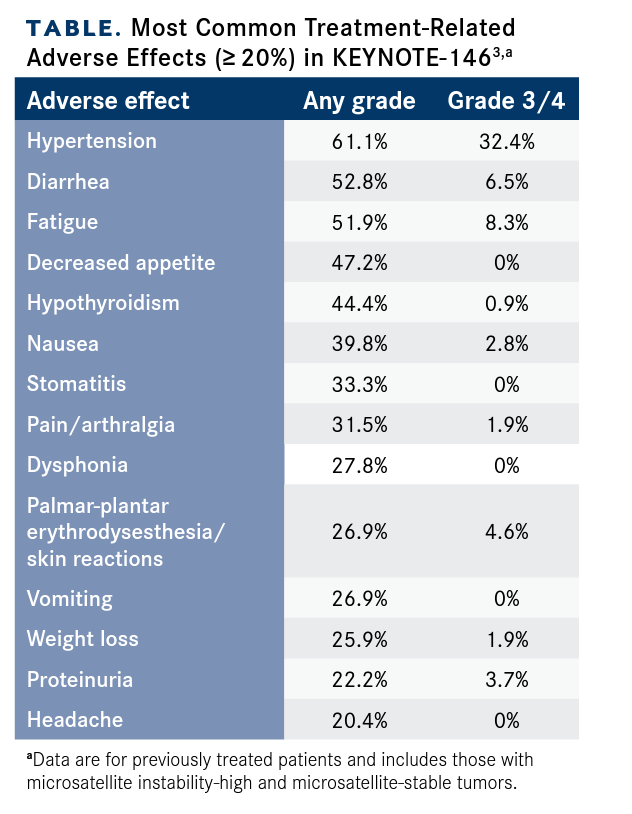Publication
Article
Oncology Live®
Combination Strategies Reshape Treatment Paradigm for Advanced Endometrial Cancer
Author(s):
As investigators expand their understanding of the biology of endometrial cancer, doors to new treatment approaches are opening, including the use of a variety of combinations that employ targeted therapies and immunotherapies.
Kathleen N. Moore, MD

As investigators expand their understanding of the biology of endometrial cancer, doors to new treatment approaches are opening, including the use of a variety of combinations that employ targeted therapies and immunotherapies.
Leveraging the efficacy data of single agents in this space has led to the development of several novel combinations that may improve standard-of-care treatment strategies. Further, the increasing under-standing of relevant biomarkers may provide the key to determining new combinations. “Endometrial cancer, for the most part, does not have the HRD [homologous recombination deficiency] signature that we think of in ovarian cancer,” Kathleen N. Moore, MD, said during a recent OncLive Peer Exchange® .
Joining Moore, a panel of gynecologic oncology experts discussed several exciting combinations for patients with advanced endometrial cancer, including a combination that has already received accelerated approval and others that are being explored in ongoing clinical trials. They also discussed their approach to treatment for patients with recurrence after second-line treatment, an area where there is a paucity of options, making it especially crucial to look for novel targets. “We’re entering a molecularly guided era with targets that heretofore were not targetable, which is exciting for all [patients with] solid tumors,” Moore said.
Pembrolizumab/Lenvatinib for Recurrent Non–MSI-High Endometrial Cancer
In 2019, the FDA granted accelerated approval to pembrolizumab (Keytruda) plus lenvatinib (Lenvima) as a second- or subsequent-line treatment for patients with advanced endometrial carcinoma not amenable to curative surgery or radiation and whose cancer is not microsatellite instability-high (MSI-H) or mismatch repair deficient (dMMR).1 This was a major milestone for these patients as pembrolizumab was previously only approved as a monotherapy for patients with MSI-H recurrent endometrial cancer.2 Efficacy of pembrolizumab/lenvatinib was demonstrated in KEYNOTE-146/Study 111 (NCT02501096), a single-arm, multicenter, open-label, multi-cohort trial that enrolled 108 patients with metastatic endometrial carcinoma that had progressed after 1 or more prior systemic therapies in any setting.3,4 The primary end point was overall response rate (ORR) at 24 weeks.
In the 94 patients whose tumors were not MSI-H or dMMR, the ORR was 36.3% (95% CI, 26.5%-46.7%).3 At the time of data cutoff for the primary analysis, there were 7 complete responses (7.4%) and 28 partial responses (29.8%), resulting in an ORR of 37.2%. The disease control rate was 84.0%. “In the water-fall plot of the original paper, basically everybody responded. That’s unheard of in second-, third-line endometrial cancer,” David M. O’Malley, MD, said.
A challenge with the pembrolizumab/lenvatinib combination, however, is its adverse effect (AE) profile (TABLE3). In KEYNOTE-146, any-grade treatment-related AEs occurred in 96.8% of patients, with 66.9% experiencing grade 3 or 4 AEs. There were 51 deaths during the study, with 4 attributed to treatment-emergent AEs: 1 each from gastrointestinal perforation, intestinal obstruction, general physical health deterioration, and metabolic encephalopathy.3 “We must get better at managing the toxicities,” O’Malley emphasized.
TABLE. Most Common Treatment-Related Adverse Effects (≥ 20%) in KEYNOTE-1463,a

Based on the nature of this combination, “you have to balance the I/O [immune-oncology] aspect, the oral aspect, and the anti-VEGF aspect,” moderator Bradley J. Monk, MD, said. The panelists indicated, however, that the toxicities are becoming easier to prepare for and manage as providers gain more experience with this regimen. “In the trenches, we’re learning how to better handle the toxicities. We’re starting at lower doses of lenvatinib. We’re learning how to deal with some of the diarrhea and hypertension,” Brian M. Slomovitz, MD, MS, said.
David M. O’Malley, MD

When discussing dosing, O’Malley said he starts his patients at 18 mg of lenvatinib for practical reasons. “It gives you a 10-mg [capsule] and two 4-mg [capsules], which allows you to get down to 14 mg much easier than waiting for a new script and a new copay. If they need dose reduction, they have the 4 mg there,” he said, noting this strategy works perfectly for a drug where 70% of patients had their dosages reduced and almost 90% required dose interruptions in clinical trials.
Moore said she starts her patients at 14 mg. “I get 2 months in, and then if they’re doing fine, I escalate them to 18 mg. I like 14 mg because I haven’t harmed anybody, and we can escalate them,” she said. She also noted that although she was worried about the toxicity of this regimen in the beginning, she has now seen how well the combination works and how important it can be for her patients, even those who are critically ill. “I can think of 3 patients who were told they needed to go on hospice but are now going to have more time because of this drug,” she said.
In contrast, Krishnansu S. Tewari, MD, said he does not start lenvatinib at a reduced dose. “I start at 20 mg, and we’ve had to drop down to 14 mg and down to 10 mg in a few patients. But I have quite a few patients who are tolerating it pretty well. The worst I’ve seen is maybe some grade 1 or 2 hypothyroidism,” he said. However, he noted that his patients are not that sick when he puts them on the combinations. Like Moore, he also has been impressed by the responses he has seen to this treatment. “When this combination works, it really works,” he said. “I can scan patients and the disease is still there, but it’s not hurting them—it’s stable. They’re doing great on the combo,” he said.
Krishnansu S. Tewari, MD

To reduce the risk of AEs, the panelists emphasized the importance of a multidisciplinary approach to care, including close collaboration with nurse practitioners. “[At my institution, nurse practitioners] take the phone calls and have strict SOPs [standard operating procedures] in place regarding hypertension and diarrhea. If you’re working together, it can really help control these symptoms,” O’Malley said. Slomovitz agreed.
“Pembrolizumab/lenvatinib doesn’t start when you take this medicine. It starts when you decide to take this medicine. From that point, you’ve got to get blood pressure under control, get nurse extenders involved, and prepare for diarrhea. If you’re prepared, I find it’s a tolerable regimen,” he said.
The panelists also discussed where pembrolizumab/lenvatinib may fall in terms of sequencing, particularly whether attempting chemotherapy before this regimen in the second line is a more prudent approach. Moore said the answer to this question is still unclear but that she leans toward using the combination. “I feel as though maybe we need to use this first. It’s probably more active, that is my gut feeling. But that’s something we need to sort out and get into the community a lot more,” she said.
Bradley J. Monk, MD

Finding Treatment Targets in the Third Line and Beyond
The panelists agreed that in the third-line setting they do next-generation sequencing to determine next steps. “[We try] to f ind an actionable mutation that’s druggable. Ideally, put [patients] on a trial. But in the absence of a trial, look for a target for which there’s an available drug, maybe for another indication that we can use for these patients,” Tewari said.
Moore said that there are many trials available for patients with endometrial cancer, which makes it easier to find options for patients. In the absence of available trials, she said she often turns to CDK4/6 inhibitors. “I tend to go to those plus letrozole [Femara]. I’ve had nice disease stabilization. It’s well tolerated. Maybe it would work for serous, but I’ve just been using it for endometrioid serous [disease and look to] other chemotherapies. But I’m mainly looking for trials to put them on,” she said.
Brian M. Slomovitz, MD, MS

In the absence of trials, hormonal therapies should be considered, O’Malley said, noting that tamoxifen showed close to a 24% response rate. “The addition of hormonal therapy in the endometrioid [carcinomas] is obviously important. In those nonendometrioid [carcinomas], I try to get bevacizumab [Avastin] in,” he said. However, he also stressed the importance of next-generation sequencing to find actionable targets. “You’ll occasionally find a BRCA [mutation]. You may find even some other HR [hormone receptor] mutations, which allow you to try to get a PARP [inhibitor] approved,” he said.
Emerging I/O Combinations Across Treatment Lines
Different I/O combinations are being explored in clinical trials for patients who are treatment naïve or have progressed on prior systemic treatments. The panelists were considerably excited about the pivotal phase 3 KEYNOTE-775 trial (NCT03517449), which compared pembrolizumab/lenvatinib with weekly paclitaxel or doxorubicin, which is considered the current standard of care.5 “We have the accelerated approval in the United States [already], but pembrolizumab [with] lenvatinib is not available internationally. Not only will this convert the accelerated approval potentially to full approval in the United States, but it will give an international opportunity,” Monk said. Data were presented at the Society of Gynecologic Oncology 2021 Annual Meeting on Women’s Cancer.
In the all-comer population, the median PFS was 7.2 months (95% CI, 5.7-7.6) with pembrolizumab/lenvatinib (n = 411) vs 3.8 months (95% CI, 3.6-4.2) in the control arm (n = 416), leading to a 44% reduction in the risk of disease progression or death (HR, 0.56; 95% CI, 0.47-0.66; P < .0001). The median OS was 18.3 months (95% CI, 15.2-20.5) vs 11.4 months (95% CI, 10.5-12.9), respectively (HR, 0.62; 95% CI, 0.51-0.75; P < .0001). The secondary end point of ORR was also improved with pembrolizumab/lenvatinib at 31.9% (95% CI, 27.4%-36.6%) vs 14.7% (95% CI, 11.4%-18.4%) with physicians’ choice therapy.
In patients with dMMR, results were similar to those observed in all comers. The median PFS was 6.6 months (95% CI, 5.6-7.4) with pembrolizumab/lenvatinib, compared with 3.8 months (95% CI, 3.6-5.0) with control therapy (HR, 0.60; 95% CI, 0.50-0.72; P <.0001). The median OS was 7.4 months (95% CI, 14.2-19.9) and 12.0 months (95% CI, 10.8-13.3), respectively (HR, 0.68; 95% CI, 0.56-0.84; P = .0001). The ORR was also improved with pembrolizumab/lenvatinib at 30.3% (95% CI, 25.5%-35.5%), compared with 15.1% (95% CI, 11.5%-19.3%).5,6
Pembrolizumab/lenvatinib is also being explored as a first-line therapy for advanced or recurrent endometrial cancer in the phase 3 LEAP-001 study (NCT03884101), which is comparing it with paclitaxel/carboplatin.7 “[This trial] may knock chemotherapy off the pedestal for the first-line treatment of endometrial cancer. It’s exciting,” Slomovitz said.Another promising combination is the addition of dostarlimab, an investigational PD-1 inhibitor, to paclitaxel/carboplatin in recurrent or primary advanced endometrial cancer.8 This combination is being assessed in the phase 3 RUBY study (NCT03981796).8
“A nice thing about this trial is it includes carcinosarcomas. We haven’t focused a lot on that, but carcinosarcomas are in the realm of advanced breast and endometrial cancers. We need better treatment options for these patients. They’re likely to respond to immunotherapy,” Slomovitz said.
Moore said the “best trial” is the phase 3 DUO-E study (NCT04269200), which is exploring PD-L1 inhibitor durvalumab (Imfinzi) and PARP inhibitor olaparib (Lynparza) in the first-line setting for patients who received a new diagnosis of advanced or recurrent endometrial cancer.9 Study participants are randomly assigned to 1 of 3 arms: arm A, which is paclitaxel/carboplatin/placebo followed by placebo maintenance; arm B, which is paclitaxel/carboplatin/durvalumab followed by durvalumab/placebo maintenance; or arm C, which is paclitaxel/carboplatin/durvalumab followed by durvalumab/olaparib maintenance. “Of course, this is stratified by MSI-H. This [trial] is open globally and accruing quite well,” she said.
The panelists also discussed an I/O combination that has shown promise in a phase 2 trial (NCT03367741) in patients with recurrent endometrial cancer, including a small subset with carcinosarcoma (n = 9): cabozantinib (Cabometyx) plus nivolumab (Opdivo).10 In the study, more than half of the patients had received 3 or more prior lines of therapy. “Median PFS for the combo was approximately 6 months versus 2 months with nivolumab alone. Even among the carcinosarcomas, 6 or 7 of these 9 patients had had prior I/O, and all 6 of those patients had partial responses,” Tewari said, noting that it is an exciting combination that merits further study.
References
- Simultaneous review decisions for pembrolizumab plus lenvatinib in Australia, Canada and US. FDA. September 17, 2019. Accessed March 14, 2021. https://bit.ly/3bNnkx1
- Marcus L, Lemery SJ, Keegan P, Pazdur R. FDA approval summary: pembrolizumab for the treatment of microsatellite instability-high solid tumors. Clin Cancer Res. 2019;25(13):3753-3758. doi:10.1158/1078-0432.CCR-18-4070
- Makker V, Taylor MH, Aghajanian C, et al. Lenvatinib plus pembrolizumab in patients with advanced endometrial cancer. J Clin Oncol. 2020;38(26):2981-2992. doi:10.1200/JCO.19.02627
- Keytruda (pembrolizumab) plus Lenvima (lenvatinib) combination demonstrated statistically significant improvement in overall survival, progression-free survival and objective response rate versus chemotherapy in patients with advanced endometrial cancer following prior systemic therapy in phase 3 study. News release. Merck. December 16, 2020. Accessed March 15, 2021. https://yhoo.it/2WjJ8b6
- Eisai to present investigational data from oncology pipeline at the Society of Gynecologic Oncology (SGO) 2021 Annual Meeting on Women’s Cancer. News release. Eisai. March 10, 2021. Accessed March 15, 2021. https://yhoo.it/3ljIkih
- Keytruda (pembrolizumab) plus Lenvima (lenvatinib) significantly improved progression-free survival and overall survival versus chemotherapy in patients with advanced endometrial cancer following prior platinum-based chemotherapy in phase 3 study. News release. Merck. March 19, 2021. Accessed March 24, 2021. https://bwnews.pr/3lSRVNm
- Pembrolizumab (MK-3475) plus lenvatinib (E7080/MK-7902) versus chemotherapy for endometrial carcinoma (ENGOT-en9 / MK-7902-001) (LEAP-001). ClinicalTrials.gov. Updated March 12, 2021. Accessed March 16, 2021. http://www.clinicaltrials.gov/ct2/show/NCT03884101
- Mirza MR, Coleman RL, Hanker LC, et al. ENGOT-EN6/NSGO-RUBY: A phase III, randomized, double-blind, multicenter study of dostarlimab + carboplatin-paclitaxel versus placebo + carboplatin-paclitaxel in recurrent or primary advanced endometrial cancer (EC). J Clin Oncol. 2020;38(suppl 15):TPS6107. doi:10.1200/JCO.2020.38.15_suppl.TPS6107
- Westin SN, Moore KN, Van Nieuwenhuysen E, et al. DUO-E/GOG-3041/ENGOT-EN10: a randomized phase III trial of first-line carboplatin (carb) and paclitaxel (pac) in combination with durvalumab (durva), followed by maintenance durva with or without olaparib (ola), in patients (pts) with newly diagnosed (nd) advanced or recurrent endometrial cancer (EC). J Clin Oncol. 2020;38(suppl 15):TPS6108. doi:10.1200/JCO.2020.38.15_suppl.TPS6108
- Lheureux S, Matei D, Konstantinopoulos PA, et al. A randomized phase II study of cabozantinib and nivolumab versus nivolumab in recurrent endometrial cancer. J Clin Oncol. 2020;38(suppl 15):6010. doi:10.1200/JCO.2020.38.15_suppl.6010



























%20(2)%201-Recovered-Recovered-Recovered-Recovered-Recovered-Recovered-Recovered-Recovered-Recovered-Recovered-Recovered-Recovered-Recovered-Recovered-Recovered-Recovered-Recovered.jpg?fit=crop&auto=format)
%20(2)%201-Recovered-Recovered-Recovered-Recovered-Recovered-Recovered-Recovered-Recovered-Recovered-Recovered-Recovered-Recovered-Recovered-Recovered-Recovered-Recovered-Recovered.jpg?fit=crop&auto=format)
